
Concept explainers
For theseries-parallel network in Fig.17.38.
a. Calculate ZT.
b. Determine Is.
c. Determine I1.
d. Find I2.
e. Find VL..
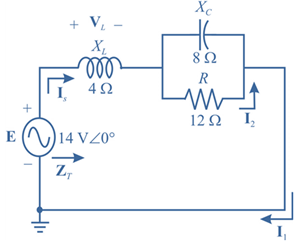
Fig.17.38
(a)
Total impedance
Answer to Problem 1P
Explanation of Solution
Given:
The given circuit is:

Calculation:
Let us modify the circuit as below to calculate the total impedance.
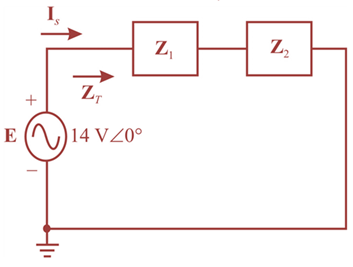
In the modified diagram,
Impedance
Impedance
Therefore, total impedance will be:
Putting the values for the total impedance:
(b)
The current
Answer to Problem 1P
Explanation of Solution
Given:
The given circuit is:
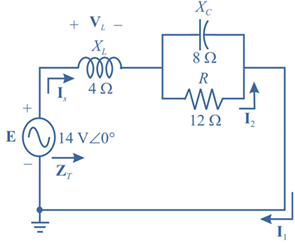
Calculation:
Let us modify the circuit as below to calculate the total impedance.
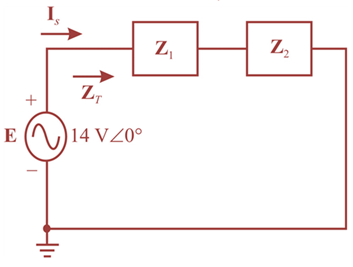
In the modified diagram,
Impedance
Impedance
Current
(c)
The current
Answer to Problem 1P
Explanation of Solution
Given:
The given circuit is:
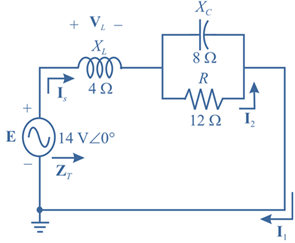
Calculation:
Let us modify the circuit as below to calculate the total impedance.
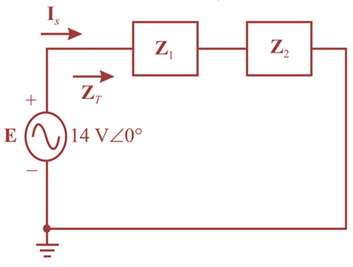
In the modified diagram,
Impedance
Impedance
Current
We can see from the circuit that,
(d)
The current
Answer to Problem 1P
Explanation of Solution
Given:
The given circuit is:
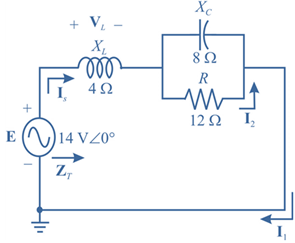
Calculation:
Let us modify the circuit as below to calculate the total impedance.
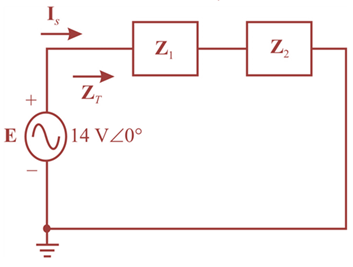
In the modified diagram,
Impedance
Impedance
Current
(e)
Voltage
Answer to Problem 1P
Explanation of Solution
Given:
The given circuit is:
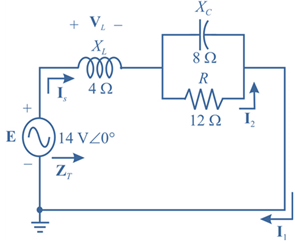
Calculation:
Let us modify the circuit as below to calculate the total impedance.
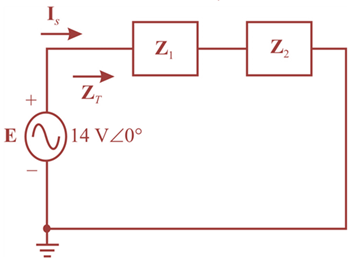
In the modified diagram,
Impedance
Impedance
Voltage
Want to see more full solutions like this?
Chapter 17 Solutions
Introductory Circuit Analysis (13th Edition)
Additional Engineering Textbook Solutions
Starting Out with Python (4th Edition)
SURVEY OF OPERATING SYSTEMS
Thermodynamics: An Engineering Approach
Database Concepts (8th Edition)
Electric Circuits. (11th Edition)
- Determine the values of the necessary resistances, design and run the circuit in TINKERCAD for an integrated 555 Astable with T1 (on time) of 8 seconds and a T2 (off time) of 4 seconds. The value for capacitor C1 must be 100 uF (0.0001 F).arrow_forward- What are Flip Flop circuits used for? Explain the operation of an R-S Flip Flop.- What function do Multiplexers or MUXs perform?arrow_forward- What function do Demultiplexers or DEMUX perform?- According to the implementation of automation circuits with ARDUINO boards, what would they be, Conceptually, the main components of any system of automation? Draw a representative schematic or block diagram.arrow_forward
- Solve problems 5.2 in detail and thank youarrow_forward5.1 Determine the three zone settings for the relay Rab in the system shown in Figure 5.26. The system nominal voltage is 138 kV, and the positive sequence impedances for the various elements are given in the figure. The transformer impedance is given in ohms as viewed from the 138 kV side. Assume that the maximum load at the relay site is 120 MVA, and select a CT ratio accordingly. The available distance relay has zone 1 and zone 2 settings from 0.2 to 10 2, and zone 3 settings from 0.5 to 40 2, in increments of 0.1 2. The angle of maximum torque can be adjusted to 75° or 80°. Remember that the zone 3 of the relay must back up the line BC, as well as the transformer. A Rab (3+j40) B (2+ j50) (0+j9) с Fu D Figure 5.26 System for problem 5.1arrow_forwardPlease solve question 4.7 in detail and thank youarrow_forward
- Solve in detail to understandarrow_forwardE2.6 Consider the following neural network. Input Sat. Linear Layer Linear Layer purelin(Wa+b) Sketch the following responses (plot the indicated variable versus p for (-3arrow_forwardE2.3 Given a two-input neuron with the following weight matrix and input vector: w=[32] and p = [-5 7], we would like to have an output of 0.5. Do you suppose that there is a combination of bias and transfer function that might allow this? i. Is there a transfer function from Table 2.1 that will do the job if the bias is zero? ii. Is there a bias that will do the job if the linear transfer function is used? If yes, what is it? iii. Is there a bias that will do the job if a log-sigmoid transfer function is used? Again, if yes, what is it? iv. Is there a bias that will do the job if a symmetrical hard limit transfer function is used? Again, if yes, what is it?arrow_forwardE2.2 Consider a single-input neuron with a bias. We would like the output to be -1 for inputs less than 3 and +1 for inputs greater than or equal to 3. i. What kind of a transfer function is required? ii. What bias would you suggest? Is your bias in any way related to the input weight? If yes, how? iii. Summarize your network by naming the transfer function and stating the bias and the weight. Draw a diagram of the network.arrow_forwardE2.1 A single input neuron has a weight of 1.3 and a bias of 3.0. What possible kinds of transfer functions, from Table 2.1, could this neuron have, if its output is given below. In each case, give the value of the input that would produce these outputs. i. 1.6 ii. 1.0 iii. 0.9963 iv. -1.0arrow_forwardQ2. The slew rate of an amplifier can cause signal distortion at its output if wrongly chosen. State the criterion for selecting the slew rate of an amplifier to avoid signal distortion. A step signal of 5 mV is applied to an inverting amplifier shown in Figure 2, which has a slew rate of 0.05 V/us. Estimate the time required for the output voltage of the amplifier to reach within 10% of its final value. If the input to Figure 2 is a sinusoidal signal of 0.02 sin(2πft) V, determine the maximum frequency that can be applied to the circuit without causing signal distortion due to the limitation of its slew rate (0.05 V/µs). In order to minimise the output offset voltage of Figure 2, a compensating resistor should be added to Figure 2. Draw a modified circuit diagram that includes the compensating resistor. Determine the appropriate value for the compensating resistor. V₁ 2 ΚΩ 100 ΚΩ +arrow_forwardarrow_back_iosSEE MORE QUESTIONSarrow_forward_ios
 Power System Analysis and Design (MindTap Course ...Electrical EngineeringISBN:9781305632134Author:J. Duncan Glover, Thomas Overbye, Mulukutla S. SarmaPublisher:Cengage Learning
Power System Analysis and Design (MindTap Course ...Electrical EngineeringISBN:9781305632134Author:J. Duncan Glover, Thomas Overbye, Mulukutla S. SarmaPublisher:Cengage Learning Electricity for Refrigeration, Heating, and Air C...Mechanical EngineeringISBN:9781337399128Author:Russell E. SmithPublisher:Cengage Learning
Electricity for Refrigeration, Heating, and Air C...Mechanical EngineeringISBN:9781337399128Author:Russell E. SmithPublisher:Cengage Learning

